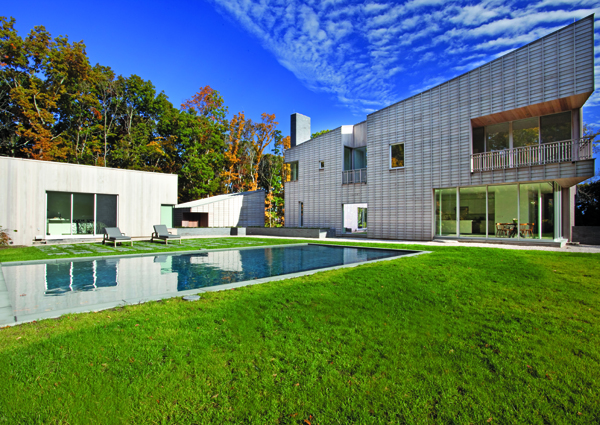
The stereotype of “The Hamptons” is known by many forms—by attitude: breezy, laid back; by style: collared shirts, flowing sundresses, straw hats; by design: whitewashed walls, exposed ceiling beams, worn wood floors.
But among the converted barns and cottage-style homes are exceptions—unusual architectural finds that range from modern marvels to imported inventiveness, and even to a house to be built upside down—that are not only surprising to see but gaining some headway in the real estate market.
“That traditional market is still the meat and potatoes,” said Gary DePersia, senior vice president and associate broker at Corcoran. “But we’re getting a swing toward something that’s different. We’re finding people that just have a different palate.”
One of Mr. DePersia’s own listings that fits the bill he describes as “Japanese Modern,” a 6,000-square-foot, six-bedroom house designed to match the style
of homes in Kyoto, Japan. With an angular, monolithic exterior, paneled with wooden and cross-hatched slats, and areas of glass that offer views into a pristine white and equally angular interior, the Shelter Island house is “not like anything you’ve seen in the Hamptons,” Mr. DePersia said.
From the outside, the shape and shingles give the house its uniqueness. From an aerial view, its diamond-like shape is reminiscent of a folded paper plane or a flying bird. Inside the house, open spaces and sharp lines dominate the design.
In the master bedroom, only the meeting of the wood floor to the master bathroom’s tile floor separates the rooms. A minimalist porcelain tub is in plain view from the bedroom, while the sink, shower and toilet are hidden behind a half wall.
Adjacent to the house on the 1-acre lot with a view of Gardiners Bay are a garage, guesthouse and pool. The two structures mimic the main house in exterior design, and the guesthouse has one glass wall that faces the pool.
“I’ve seen a lot of modern architecture,” Mr. DePersia said, “but nothing quite like this. It’s so well designed and so well thought out.”
In Sagaponack, a 3,000-square-foot on Parsonage Lane is set apart from its neighbors by design with an air of mystery, said Matthew Breitenbach, also a vice president and associate broker at Corcoran.
“I think it’s surprising,” he said. “People see it from the front and don’t necessarily know what to expect when they get inside.”
From the driveway, the house is a sprawling set of peaks that distract from taller peaks behind them. The floor plan is equally angular, giving each room corners where one would expect a flat wall, and presenting the opportunity for light to enter from multiple angles and views that open up to acres of farm reserve.
The kitchen, Mr. Breitenbach said, is especially appealing. Though the exterior of the house looks rustic, the kitchen is very modern, he said, with floor-to-ceiling windows, and a large, marble-topped, U-shaped island flanked by mirrors.
“People tend to gravitate toward the kitchen anyway,” he said. “But this is a very modern, open kitchen, living room and dining area that is amazing for entertaining.”
A floating staircase rounds out the unusual features, according to Mr. Breitenbach. “People are definitely very impressed,” he said. “It doesn’t look like some spec house. It feels custom-built, custom-designed and custom-renovated.”
To architect Blaze Makoid, the uniqueness of his buildings come from the uniqueness of his goals. In working with an investor group focused on developing modern houses in an oceanfront setting, Mr. Makoid said his design was based on the group’s goal of creating “lasting” design that optimizes “volumes, views and materials.”
Based on those principles, Mr. Makoid designed what he calls an “upside-down” house, which will be built on Dune Road in Bridgehampton on the eastern, oceanside strip of land with a view of Mecox Bay. Rather than design based in sharp angles, like the houses in Shelter Island and Sagaponack, the overarching shape in Mr. Makoid’s design is a large, sweeping S-shape, a curved, uninterrupted line that creates the ceiling and separate floors of the house. Guests will enter the house on the second floor, Mr. Makoid said, which will have the kitchen and living spaces, while the bottom floor of the house will be for bedrooms, which will keep them more private. The outdoor deck and a pool that runs the width of the house are also located on the second floor.
On the second floor, the living room and outdoor lounge area face the ocean, and the kitchen and guest suite are on the opposite side of the house, accessed by two bridges.
Mr. Makoid said he designed the house with the idea of connecting the two bodies of water that surround it.
“It’s rare to be in a house and see water on both sides,” he said. “But a lot of that land is unbuildable, so there will always be that view of Mecox Pond. We wanted to take advantage of that.”
He said because of the landscape, which has high dunes, he thought it made more sense to put the private space on the lower floor, where it is mostly out of sight, and have the public space on the upper floor, which is more exposed.
Mr. Makoid said the entrance brings guests directly into the center of the second floor, where the room seems to “explode horizontally,” as if turning around, the guest is looking at one continued panorama of waterfront views. He said he expects the house to be finished in about 18 months.
“It’s sort of like a surreal experience as you take in each aspect of the view,” he said. “I’m anticipating the reaction will be kind of mind-blowing.”